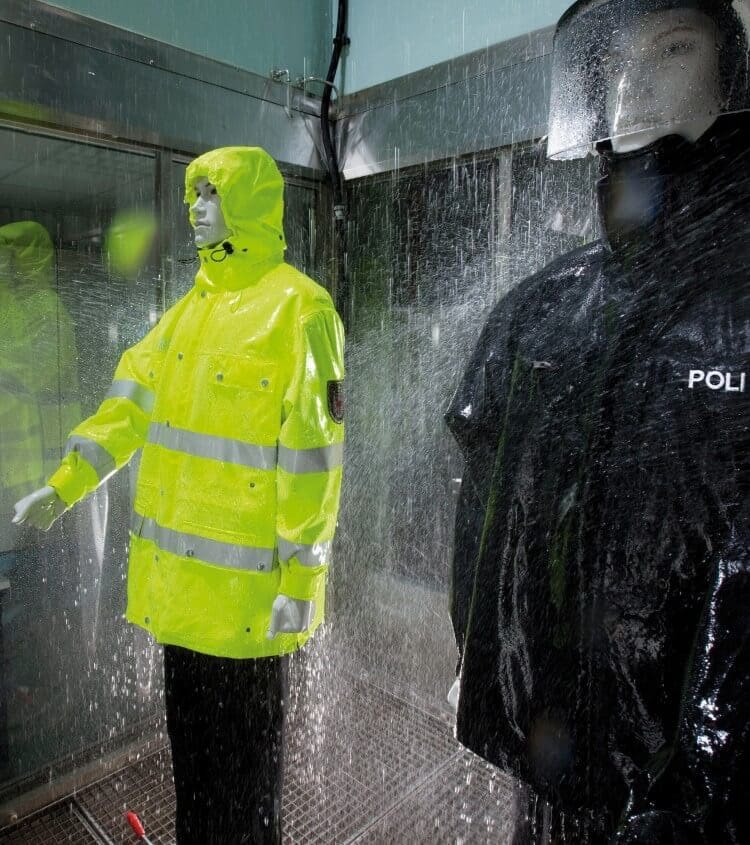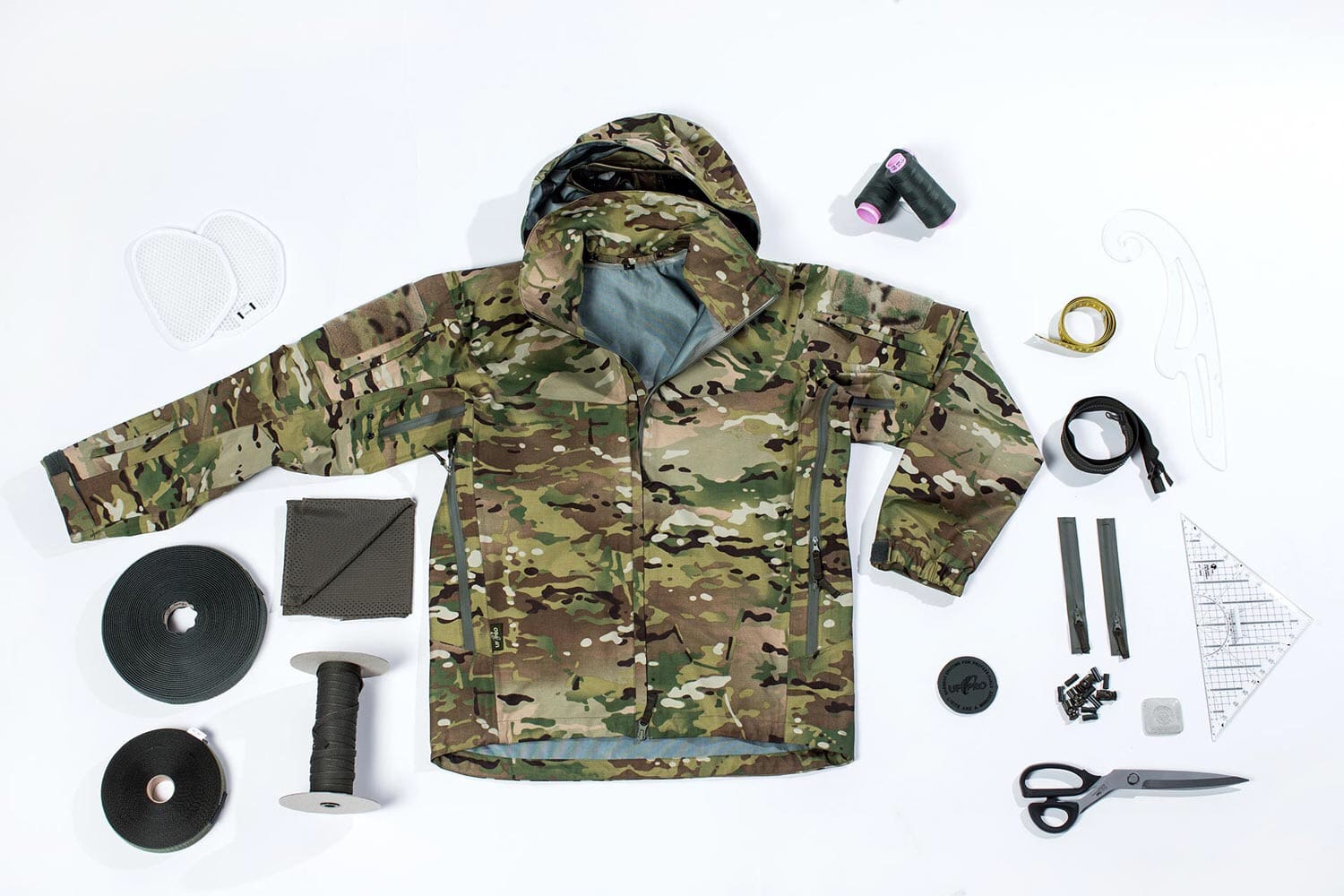Author: Armin Wagner
There is quite a mix up regarding waterproof and water repellent textiles. Most of the times, these terms are used synonymously. But there is a big technical difference between them, especially when the expectation is to stay dry in adverse weather conditions.
The significant difference between a waterproof and a water repellent garment is that you’ll probably get wet in a water-repellent garment, especially when exposed to rain for a longer period or under certain wear conditions.
Whereas in a garment made of waterproof textiles one should stay dry, however long and in whatsoever conditions.
Continue reading to find out more about the pros and cons of waterproof and water-repellent clothing. We’ll also explain what DWR means and how you can retain it even after multiple washes.
HOW IS THE DIFFERENCE DEFINED?
The difference between water-repellent and waterproof garments is based on the definition which is applied by the textile industry for waterproofness.
International standards define a water entry pressure of 800mm (hydrostatic water column) above which a textile material (not the finished garment) can be called waterproof. Everything below that can be called only water-repellent.
WHAT IS A HYDROSTATIC WATER COLUMN?
A hydrostatic water column describes the amount of height of a theoretical column of water, which is pressing on the surface of the fabric. So the water column always corresponds to a certain pressure.
A water column of 10 meter (= 1.000 cm, = 10.000mm) equals a pressure of 1 bar, or 100Kilopascal.
WATER-REPELLENT CLOTHING.
As per definition, textiles with a water entry pressure below 800mm water column or 0,8 bar, can be called water repellent.
This might be enough to stay dry if one is only for a short time exposed to rain or any moisture, which is not pressed onto the textile.
As water-repellent materials usually do not contain any kind of membrane of compact coating, the so-called breathability of these materials is in most cases better than the one in waterproof materials.
This is quite logic, as they have a higher air permeability and also sweat, or better moisture vapour can permeate much easier.
WATERPROOF CLOTHING.
A waterproof material, as per definition above is not the guarantee for waterproof garments.
Also, the overall design of a garment has to prevent rain to enter into the inner layers of the clothing system. That means that all closures, all seams, all edges must block any potential water entry attempts.
To prevent moisture to penetrate the seams, all seams which connect the outside of a garment with the inside of it have to be sealed with a seam sealing tape.
These seals have to be durable to washing, drying and any kind of wear and tear. They have to be durably waterproof.
As water usually finds a way to enter, wherever there is the slightest possibility to enter, this is quite a challenge.
Especially around edges, one might experience that without proper barriers, moisture can be seen wicking around them and all the way up into the inside of a garment.
Critical are the lower hems of the torso and the sleeves, but also the edges of the hood are neuralgic areas for wicking effects. To avoid this, wicking barriers have to be applied in these areas.
DOES THAT DEFINITION ASSURE THE WEARER TO STAY ALWAYS DRY?
Especially while sitting or kneeling there might occur water entry pressures, which are much higher than 800mm.
That means that depending on how the garment is used the wearer still might get wet, even though the textile is classified by the above definition as waterproof.
Therefore, most of the high-performance waterproof garments are made of textiles, which block the water entry at much higher pressures.
GORE-TEX® laminates, for example, have been tested with a very sophisticated test instrument, which applied a water entry pressure of more than 100 meters. And still, there was no water penetration through the laminate.
Read more about the performances of GORE-TEX fabrics.
Today a truly reliable and durable waterproof performance can only be achieved with membrane-based products.
In these products, the membrane is the primary barrier to any water entry.
The chemical and physical characteristics of these membranes define not only the limits of the water entry pressure but also their durability.
Especially polyester and polyurethane based membranes seem to have a tendency to get weaker over time and sooner or later their performance drops below the critical thresholds.
This might be the result of UV radiation, ageing, flexing, high or low temperatures and of course also of numerous washing cycles.
Still, the bi-component ePTFE membranes, which are used by GORE-TEX®, Event and some other brand membrane manufacturers show the best results regarding the durability of its waterproof characteristics.
But what all of the membrane systems have in common is that if they are punctured, they will leak.
In fact this is the most common reason for all failures, which we experienced over the last 20 years.
Punctures can be caused by any kind of pointed, edged objects.
Very popular are for example pine needles which cover the ground in forests, thorns of bushes, but also dirt, which accumulates over time within the fabric structure.
DURABLE WATER-REPELLENT TREATMENT.
The water-repellent characteristic is in common textile materials achieved by a thermal and chemical treatment of the fabric during its manufacturing process.
This is called a DWR, or “durable water repellent finishing.
Even waterproof fabrics have a DWR treatment, even though the waterproof component (membrane or coating) by itself is already waterproof.
As a matter of fact, when we have the waterproof performance of our GORE-TEX® gear tested, then the DWR is completely washed down, and the garment still has to be waterproof.
So why is this?
4 REASONS WHY DWR IS APPLIED TO ALREADY WATERPROOFED CLOTHING.
1. PREVENTING LEAKS DUE TO SLOPPY CONSTRUCTION WORK
Applying DWR treatment to already waterproofed garments acts as a safeguard against sloppy construction of the sort that might permit leaks to develop following heavy usage or multiple washings.
Before a garment made of GORE-TEX® can be marketed, it must pass the GORE-TEX® Performance Standard (GPS) test to prove its waterproof-worthiness.
Conditioning approval to market a product upon passage of the GPS test is unique to GORE-TEX®.
Does that mean garments will not be waterproof if made of membrane products other than GORE-TEX®?
No.
It simply means that any GORE-TEX® garment you buy will come with a guarantee that it passed a demanding test to prove it is waterproof.
In order to conduct GPS testing, we first need to wash down the initial or subsequent DWR treatment so that any construction deficiencies can become evident.
2. DWR PREVENTS WATER FROM ADDING WEIGHT
All membrane products have an upper or outside fabric layer (also called the face fabric).
The membrane is always located behind this layer.
DWR prevents the face fabric from absorbing moisture or water.
This is important because absorbed water adds weight to the garment. In some cases, the weight gain can be significant.
Good DWR treatment ensures that the garment retains its actual weight, even after hours of exposure to heavy rain.
3. DWR AVOIDS PSEUDO-LEAKAGES
Another benefit of good DWR treatment is it prevents you from feeling as if the garment is leaking.
If the face fabric becomes soaking wet, it will create a sensation of clamminess between your body and the inner fabric.
The garment might not be actually leaking, but the clamminess can make you swear that it is.
It’s a nasty effect, no doubt about it. One way to fight that feeling of clamminess is to create interior “air cushions“, by using our air/pac® inserts.
The air/pac® inserts help enormously, but only in the exact position, where you place them – and where they are designed to go is in just the most critical areas.
In all the other areas, one has to rely on a proper DWR.
4. ACTS AS A TEMPORARY PATCH OVER MICRO HOLES
Sooner or later and after you’ve subjected your waterproof garment to rugged outdoor use, the membrane will almost surely develop micro-holes.
This is hard to avoid, especially when you wear a rucksack, chest rig, or similar other gear atop your garment.
Your garment is also bound to come into contact with pine needles, sand, earth and other small particles.
From this contact micro-damage to the garment’s membrane occurs.
You can minimize the potential for this problem by washing your garment thoroughly after outdoor use.
This helps flush away particles that can become trapped within the outer fabric structure – particles that, if left alone, will tend to burrow through the membrane.
DWR is your best defence. It can act as a temporary patch over micro-holes in the membrane, thereby keeping water and moisture at bay so that you can remain dry.
However, you won’t remain dry indefinitely. The patch effect lasts only until you subject your garment to pressure.
In light of all this, is it important to apply a DWR treatment to already waterproofed garments? Undoubtedly, yes!
But is it also important to apply a DWR treatment after a routine washing?
Very possibly. Here’s why.
DWR is not permanent; it loses its integrity over time and dissipates. So it needs to be renewed after a protracted time of wearing or many wash cycles.
However, there are some things you can do prior to applying DWR that will make the treatment’s effects last longer.
HOW TO RETAIN THE DWR?
Step 1: Check the quality of the DWR treatment
You can test the quality of the DWR by yourself. Just put some water on your gear and check if the water stays round like a little drop.
If this drop flattens and spreads immediately after applied, it gets absorbed by the outer fabric, then it might be the right time to do something aginst it.
Step 2: Iron or tumble-dry your clothing
You can reactivate the initially applied DWR simply by ironing the outer side of your rain gear.
This will help you to retain a good DWR performance for some time and before using some chemicals, which might pollute the water, and might also affect the breathability of your gear.
Also what you can do is to dry the clothing in a dryer and like this reactivate the DWR treatment to some degree.
Step 3 (in case step 2 isn’t sufficient): Apply water-repellent treatment
In case you think it’s time to apply something, then my personal preference is to apply the treatment solely on the outside of the garment, instead of the washing machine procedure.
Why? I prefer that on the inside of the jacket my body sweat is spread over an as big as possible surface so that it can evaporate through the membrane and to the outside as quickly as possible.
If there is DWR on the inside of the garment, then moisture might not spread that efficient, but condensate and run down the inside of the garment.
ARE GARMENTS MADE OF WATERPROOF LAMINATES ALWAYS WATERPROOF?
Not all clothes made out of a waterproof material are 100% waterproof. Its construction significantly defines the level of waterproofness.
As a matter of fact, also a lot of soft-shell garments are based on membranes with a water column of way over 800mm.
But due to its structure, the seam of soft-shell garments are impossible to be reliably sealed.
Therefore, water will after a longer time of rain exposure enter into the clothing.
Also, mechanical damages of the membrane, which might be the result of edged objects like dirt or pine needles can perforate the membrane.
These damages have to be professionally repaired.
If you encounter a potential leakage in your Monsoon waterproof garment, then please send them back to us with a precise description where you think the leakage occurred.
We will try to locate the damage and repair it for you.
About the author:
ARMIN WAGNER
is the mastermind behind all UF PRO® products. With over 25 years of experience in the textile industry for law enforcement and military units, and after working for some of the industry’s leading companies, like W.L. Gore, Second Chance and Armour Holdings, Armin finally landed at, as he describes it, his dream job, as the head of product development at UF PRO®.
Tags: UF PRO







This is exactly the kinda articles that first got me revisiting SSD on a daily basis.. thanks for the info Eric
Spot On ! This is a wealth of knowledge, broke down in crayon.
Good article.
Id like to know a few things; how different fabric laminates affect the properties (water resistence and breathability) of the membrane. How overwhelming a membrane (all membrane/fabric laminates reach the limits of their optimal properties at some point) pans out – do they fail at an even curve or not. And how multiple layers of membraned fabric affect breathability (pockets, multiple garments).
Realize this is a bit beyond the scope of the article, but having seen a lot on how great these things are id like to know where they fail so i can factor it in, like i would any critical process.
Good info to know. Another reason for a good DWR treatment on waterproof/breathable garments relates to ‘pseudo-leakages’. A wetted outer surface will inhibit the membranes breathable function, as a film of water will block water vapor (sweat) from leaving the garment. DWR is very important.
Great article!
I’m curious as to what material/product is utilized for the wicking barrier mentioned in the article.
Great article.
I also work in the outdoor apparel world and know, first hand, how difficult it is for consumers to understand the differences in levels of protection.
There are other considerations- like not solely relying on vapor permeable membranes for vapor to leave a waterproof garment. Pit zips and other mechanical type vents are critical. A human body, at exercise, can produce over 2 liters of sweet an hour. Current membrane-based fabrics can’t keep up with that on their own.
Great read, now I know why I spent Friday soaked to the bone.
800 mm = 0.08 bar
As we say, “Resistance for warmth and breathability for comfort”. Fritzthedog brings up some good points. We look at protection much like architecture while materials are important there are different ways design can contribute to the function of comfort and protection. If a house was waterproof it would rot from the inside, one technique is using soffits in the eaves of the roof not dissimilar from pit vents as an example. Another approach is a bit of a hybrid both physically building a more water resistant fabric ie calendared and treating it with a DWR, with the right construction and a warm body inside you have a more durable solution than just treatment. In buildings air movement (HVAC) plays a large roll in comfort, imagine using that warm body, the right insulation and encapsulation as that HVAC system….We build shelters but many of the techniques apply to garments as well. Good stuff thanks for the article.